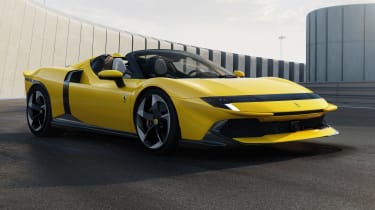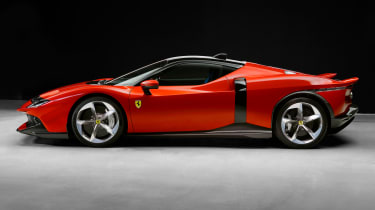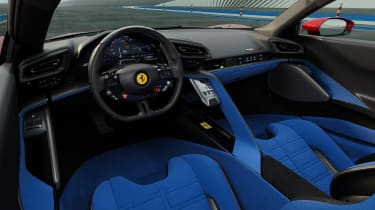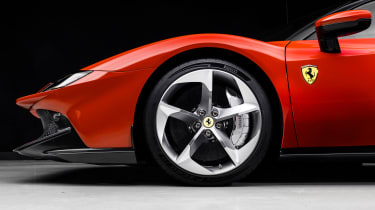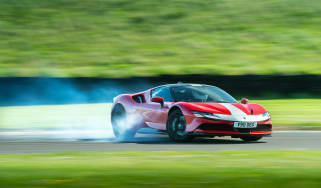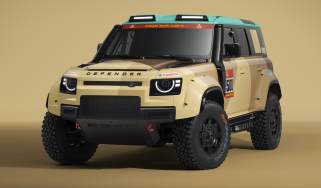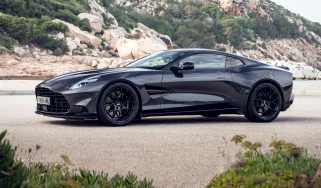The Ferrari Testarossa is officially back, and it’s a 1035bhp V8 hybrid
Ferrari has launched the 849 Testarossa to fill the gap left by the SF90, taking inspiration from models of the past and its flagship F80 hypercar
It’s been a year since Ferrari pulled the plug (pun intended) on its hybrid SF90 supercar, and after a few rounds of test mule sightings, a replacement has finally arrived in the form of the Ferrari 849 Testarossa. Designed to slot into the gap left by the SF90, this new model has been launched in standard coupe, Spider and Assetto Fiorano forms, with deliveries beginning in Q2 2026 (Q3 for the Spider). UK pricing is still under wraps but customers can expect to pay from around £400,000.
It’s no secret that evo didn’t immediately bond with the SF90. Its performance was breathtakingly impressive but its vast capabilities were far from easy to unlock and enjoy on Britain’s roads. With the 849 Testarossa, Ferrari has worked hard to not only increase overall performance but also its accessibility, giving it a complete design overhaul inside and out in the process.
Unlike SF90, this car revives an iconic nameplate from Ferrari’s back catalogue, with Testarossa having first surfaced in 1955. As for the 849 badge, the ‘8’ refers to the number of cylinders, with 49 referencing the capacity of each of those cylinders (490cc). For our first glimpse at Ferrari’s new series-production flagship, we travelled to Milan to speak with its creators.
> Ferrari F80 2025 review – hybrid V6 hypercar is a worthy successor to the LaFerrari
Engine, transmission and 0-62mph
Despite the fresh name and bold new design, the 849’s core components are familiar. Mounted midship is a derivative of the same 4-litre twin-turbocharged dry-sump V8 in the SF90 (now with a new F154FC engine code), but almost every component has seen some attention. The block, camshaft, crankshaft, plenums, valvetrain and even the fuel rails have all seen revisions in the pursuit of increased performance, with the cylinder heads now cast from recycled aluminium (80 per cent of the engine’s weight is now made from recycled alloys). The result is a 49bhp bump in output from the engine to 818bhp, a 31lb ft torque increase to 621lb ft, and a redline increased by 300rpm to match the 8300rpm cut-off of the hardcore SF90 XX.
The changes don’t stop there, with the twin turbochargers being entirely new for this model and the largest fitted to any model in the range, F80 aside. Not only are they larger than before, they feature the same low-friction bearings as the F80, trick turbine heat shielding derived from the 296 GT3 racer and have seen revisions to the compressor wheels, turbines and overall calibration for improved response. While the 849 does go without the electric turbo spool assistance of the F80, Ferrari claims it has ‘zero’ lag.
Despite all of these upgrades, the 849 Testarossa isn’t any heavier than an SF90. Dry weight stands at an identical 1570kg (we’ve weighed an SF90 at around 1740kg in running order) which, when combined with the power increase, makes for a 31bhp/ton uplift in power-to-weight. 0-62mph is now said to come over two tenths sooner than before at 2.25sec, with the top speed claimed to be ‘over 205mph’, and likely to at least match the SF90’s 211mph maximum.
The sound that accompanies this performance is important too, and Ferrari has tried its best to work its way around ever-tightening regulations to enhance the aural experience. While increasing exterior volume is borderline impossible, Ferrari’s engineers have instead focused on boosting cabin noise with a system that pipes genuine intake sound inside depending on intake pressure and G forces, measured with an accelerometer. The Testarossa also features new transmission mapping for more precise up- and downshifts, with associated on and off-throttle sounds also given attention too – the increase in diameter and length of its Inconel exhaust manifold has gone some way to achieving this. Given the stirring sound of the 296 GTS we recently tested, we’re very intrigued to see what Ferrari has pulled off.
While an increase in electric power output is perhaps an easier way to give numbers a boost, Ferrari hasn’t gone down this route with the Testarossa. Instead the hybrid system is untouched, with the same 7.45kWh lithium-ion battery pack mounted behind the seats powering the same three motors: one as an MGU-K that drives the rear, and two on the front axle. Output of this system remains unchanged at 217bhp (as does electric-only range at 15.5 miles) but a lot of work has gone into optimising its calibration for a smoother transition between electric and combustion drive.
Chassis and aerodynamics
Overall weight might be identical to the car it replaces, but Ferrari claims the Testarossa feels considerably lighter (up to 350kg lighter than its actual weight), largely thanks to the use of new stability systems and a recalibration of those torque vectoring front axle motors. Ferrari’s become renowned for its love for acronyms in recent years, and it’s taken things to the extreme with this car. Featuring the likes of SSC (Side Slip Control) 9.0, SCM, FDE 2.0, EPS, ABS Evo and performance EBD, it’s all a little overwhelming, but the new ‘Ferrari Integrated Vehicle Estimator’ (FIVE) system is the most notable addition.
First seen on the F80, the Testarossa features its own implementation of the predictive stability program, giving the driver a subtle helping hand at the limit (the system remains engaged even when the Manettino is set to ESC off). Designed to feel completely natural (it certainly does in the F80), it effectively operates one step ahead of the driver by analysing speed, steering angle and other parameters, predicting the next input and acting accordingly. Combined with various other systems, it makes the Testarossa the most electronically advanced Ferrari on sale.
Braking hardware has seen an upgrade with improved rear calipers and new discs on both axles, developed in partnership with Brembo, and the latest generation of Ferrari’s ‘ABS Evo’ system helps extract the most from these components. Further improving the feel and response of its brake-by-wire system, Ferrari claims that the 124mph-0 time has seen a 6 per cent improvement over SF90, with the step between regenerative and hydraulic braking further refined. Optional Michelin Pilot Sport Cup 2R tyres (265/35 front, 325/30 rear) will certainly help in this department too. Assetto Fiorano cars get Cup 2s as standard, with the Pirelli P Zero R standard on the base car and Bridgestone Potenza Sport the run-flat option.
Chassis setup is said to sit between standard SF90 and the hardcore SF90 XX, with stiffer single-rate Multimatic shock absorbers equipped as standard and springs 35 per cent lighter than on the SF90 – the result is a 10 per cent reduction in roll overall. Opt for the Assetto Fiorano package and weight drops by 30kg through the use of more carbonfibre and titanium, with new seats responsible for 18kg of this. A revised suspension setup (now with front-axle lift for the first time), carbonfibre wheels and a 25 per cent increase in downforce over the standard car are further changes, going some way to justify the package’s €52,500 (c£45,000) price tag.
If you’re not keen on the additional cost, the standard car has plenty to shout about. Downforce at 155mph stands at 415kg, 25kg more than the SF90, with the new double rear wing and active central spoiler contributing 100kg alone. Subtle canards, a reprofiled splitter, an additional two underbody vortex generators (for a total of three) and a deep rear diffuser work the air harder too, with work done to boost cooling performance by 15 per cent.
Design and interior
The Testarossa’s design is the most notable change, as while it’s a radical overhaul, it shares no visual ties to the cars with which it shares a name. Instead, Ferrari design director Flavio Manzoni says it takes inspiration from sports prototypes of the 1970s, while also borrowing the bold, vertical, geometric design language seen on the likes of the F80 and 12 Cilindri.
For the Testarossa, the aesthetic of the SF90 has been swapped for a much more radical look. Form very much follows function, with Manzoni spending much of the design development in conversation with the aerodynamics team in order to find a middle ground. The doors are one of the most radical features, deep cut like those on the F80 in order to create a path for airflow to reach an enlarged intercooler taken from the F80. These doors were one of the most complex elements to achieve given the tight surfacing, constructed from a single piece of aluminium. Ferrari saw failures in initial prototypes given the stresses the material was under, but managed to find a reliable construction method that worked for production.
Another element sculpted by aero is the distinctive double tail at the rear, referencing sports prototypes like the 512 S and giving the impression of a more cab-forward design. The Testarossa is in fact longer than the SF90 as a result (by 8mm), and while regulations prevent wings from protruding beyond the bumper, Ferrari found a clever workaround: make those wing pieces part of the bumper itself.
The front end gets the same treatment as the F80 and 12Cilindri with a horizontal visor between the headlights, but in this application combined with small vertical headlights, it makes for a more square aesthetic. Head-on it has elements of the Daytona and 308 as opposed to a Testarossa, and when asked where a number plate goes, Manzoni replied: ‘Oh my God… we don’t put a plate.’
The cabin is heavily inspired by the F80 with a floating central ‘sail’ being home for the gear selector, and the steering wheel adopting physical controls – including for the all-important start button. The digital dash layout is similar to the SF90’s, but it too has been tweaked for improved usability – this, we expect, will be popular with customers given how fiddly Ferrari’s HMI system can be.
One of the key sticking points of the SF90 was its lack of storage space, and this hasn’t been rectified. A total of 74 litres of boot capacity under the bonnet is an identical match for the SF90, with a slight reprofile of the door said to allow for marginally more space in the door cards (although we struggle to see it). When pushed on the point of storage, Chief Marketing and Commercial Officer Enrico Galleria doubled down by saying, ‘What is luggage space?’, suggesting owners buy a van instead. Ferrari has positioned the 849 as the top of the range ‘pilot’ car for those looking for maximum performance, with the models beneath it offering more practicality. As logical as this sounds, we feel buyers might not be as keen to purchase a Ford Transit specifically for a road trip to the Continent as Ferrari thinks.
The Ferrari 849 Testarossa coupe will hit the road in Q2 2026 before first Spider deliveries begin in Q3 – curiously, Ferrari expects the Spider:coupe split to be biased to the drop-top at around 55:45, with more buyers preferring the flexibility of the folding hard-top. Prices begin at €460k for the coupe, rising by €40k for the Spider – exact UK pricing is to be announced early next year but expect the coupe to start at around the £400,000 mark.
We had our reservations about the SF90 that this car is based on, but given the steps Ferrari has made in the F80 since, we can’t wait to see how the new Testarossa performs in the real world.
Ferrari 849 Testarossa specs
- Engine 4-litre twin-turbocharged V8 & three electric motors
- Transmission Eight-speed dual-clutch
- Power 1035bhp combined
- Torque 621lb ft (engine only)
- 0-62mph 2.25sec
- Top speed >205mph
- Power-to-weight 659bhp/ton (dry)
- Weight (dry) 1570kg (c1660kg Spider)
- Price from €460k (c£400k)
